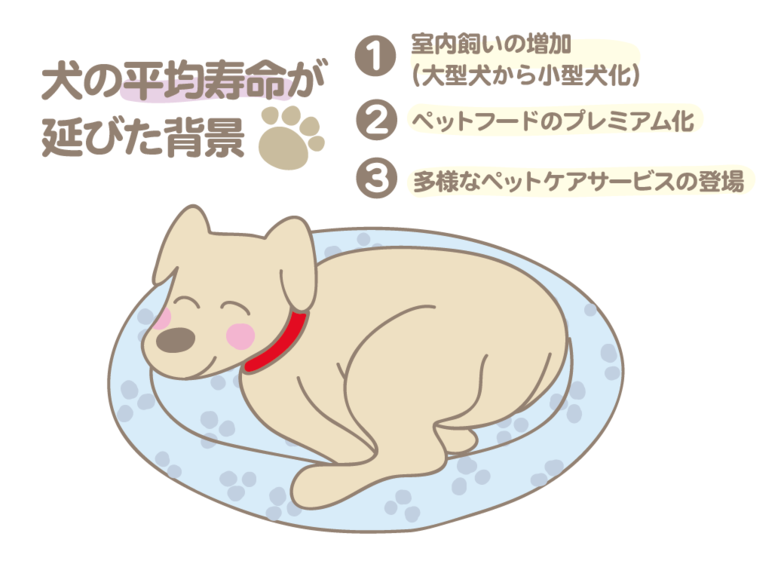While the human world faces cries of declining birthrates and an aging population, did you know that aging has actually begun in the pet world too?
Looking at surveys conducted by the Japan Pet Food Association, the average lifespan of dogs was 13.9 years in 2011 and increased slightly to 14.2 years in the latest 2013 data. It is said that pet lifespans have increased dramatically over the past decade or so due to changes in the environment in which they are kept.
The background factors include:

■Increase in indoor pet ownership (shift from large to small breeds)
■Premiumization of pet food
■Emergence of diverse pet care services
These three factors are believed to exist.
Dogs are inherently believed to have longer lifespans in small and toy breeds compared to large breeds. Beyond this fundamental difference, the increase in indoor housing over outdoor living has also reduced the incidence of illness among dogs. Furthermore, the enhanced nutritional value and effectiveness of pet food have also contributed to the extension of average lifespans.
Let's also look at it from another perspective.
The pet care products market was valued at 66.6 billion yen in 2009, 69.9 billion yen in 2013, and is projected to reach 74.1 billion yen by 2018 (2014 Pet-Related Market Marketing Overview / Fuji Keizai). Particularly, the pet diaper market has continued to grow annually in recent years, corresponding to the advancing aging of the pet population (25.4 billion yen in 2014, a 38.2% increase year-on-year). a 38.2% increase year-on-year). The pet supplement market also reached ¥3.55 billion in 2014, achieving 26.8% growth compared to the previous year. These facts also hint at the aging of pets.
Services are also emerging to prepare for this aging pet population. This includes pet nursing care.
As pets age, just like humans, they become more susceptible to illness, develop joint problems, and may suffer from cataracts that impair their vision. Numerous specialized care services have emerged for these pets and their owners.
Among these aspects of life with pets, what I find particularly noteworthy is "pet rehabilitation (and physical therapy)."
As pets age more like humans, the likelihood of them needing surgeries and other procedures will probably increase. Additionally, addressing physical discomfort arising from old age—such as difficulty moving or sluggish leg movement—will become necessary.
This is where "rehabilitation (and physical therapy)" becomes essential.
Pet rehabilitation is considered advanced in countries like Australia, Sweden, and the United States, while Japan has yet to fully catch up with its implementation. Only recently has it begun to gain attention in Japan.
Overseas, various approaches exist, such as the existence of nationally certified "animal physical therapists" or human physical therapists extending their practice to animals. However, in Japan, the establishment of such qualifications is still incomplete (though private certifications and organizations do exist).
Rehabilitation is primarily conducted in water. The basic format involves entering a large pool with the pet and providing support to help them move their body. The pet's weight is buoyed by the water's buoyancy, enabling them to move their body.
While large animal hospitals are beginning to introduce it, I sincerely hope that both current pet owners and those considering getting a pet will keep "pet rehabilitation" in mind for the day it might be needed.
Pets are truly similar to us humans.
As they age, their physical functions decline, but with training, they can learn and recover.
At Design with Pet Project, we will continue to promote the creation of a society where humans and pets coexist in 2015, while also keeping an eye on these new trends emerging in the pet industry.





